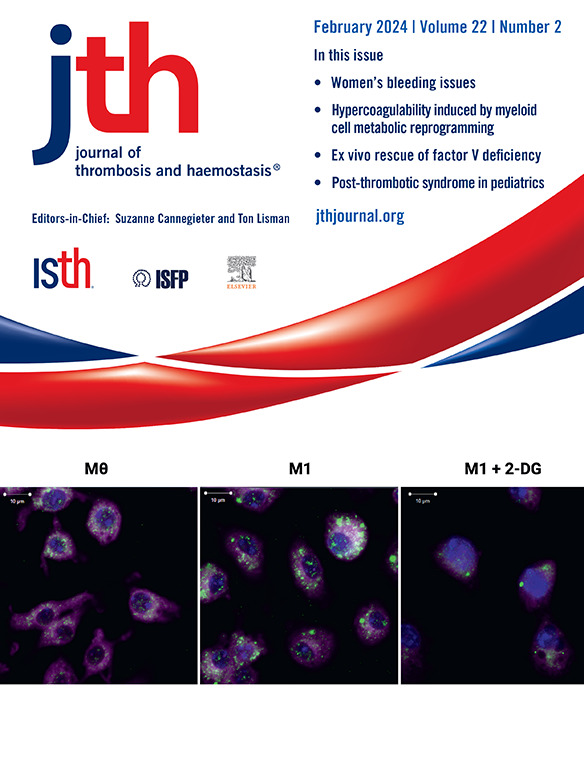Impact of diagnostic coding schemas on major bleeding risk assessment for oral anticoagulants in patients with atrial fibrillation using administrative claims data
IF 5.5
2区 医学
Q1 HEMATOLOGY
引用次数: 0
Abstract
Background
Reliable diagnostic coding schemas are essential for accurately assessing bleeding risks in patients on oral anticoagulants, particularly in observational studies.
Objectives
This study evaluated how different published diagnostic coding schemas impact the assessment of major bleeding risks associated with direct oral anticoagulants (DOACs) and warfarin.
Methods
This retrospective cohort study included patients with atrial fibrillation who initiated DOACs or warfarin between 2012 and 2019 using Taiwan’s national claims database. Major bleeding events, including gastrointestinal bleeding, intracranial hemorrhage (ICH), and other major bleeding events, were identified using coding schemas from Cunningham et al., the Mini-Sentinel protocol, and Yao et al. Propensity score matching was performed to ensure covariate balance. Incidence rates and hazard ratios (HRs) were estimated to evaluate the bleeding risks.
Results
After matching, each cohort comprised 20 704 patients. The number of reported major bleeding events was influenced by the strictness of the coding schema, with Cunningham yielding the most events, followed by the Mini-Sentinel and Yao schemas. DOACs were associated with a consistently lower risk of composite major bleeding (HR range across different coding schemas, 0.73-0.76; all P < .05) and ICH (HR range, 0.43-0.63; all P < .05) but not gastrointestinal bleeding (HR range, 0.87-0.90; all P > .05), regardless of the coding schema applied. Restricting ICH definitions to primary diagnosis or spontaneous cases revealed a more pronounced reduction in ICH risk associated with DOACs.
Conclusion
While the choice of coding schemas has a negligible impact on overall bleeding risk comparisons between DOACs and warfarin, it significantly affects ICH risk assessment. This underscores the importance of careful coding schema selection in observational studies evaluating major bleeding risks.
使用行政索赔数据的诊断编码方案对房颤患者口服抗凝剂大出血风险评估的影响
本研究评估了不同已发表的诊断编码方案对直接口服抗凝剂(DOACs)和华法林相关大出血风险评估的影响。主要出血事件,包括胃肠道出血(GIB)、颅内出血(ICH)和其他主要出血事件,使用来自Cunningham等人、Mini-Sentinel协议和Yao等人的编码模式进行识别。进行倾向评分匹配以确保协变量平衡。估计发生率和危险比(hr)来评估出血风险。结果:匹配后,每个队列包括20,704例患者。报告的主要出血事件的数量受编码模式的严格性的影响,以Cunningham模式产生的事件最多,其次是Mini-Sentinel和Yao模式。DOACs与复合大出血的风险持续降低相关(不同编码模式的HR范围:0.73-0.76,均P0.05),无论应用哪种编码模式。将脑出血定义限制为原发性诊断或自发性病例显示与DOACs相关的脑出血风险更明显降低。结论:虽然编码模式的选择对DOACs和华法林之间总体出血风险比较的影响可以忽略不计,但它对ICH风险评估有显著影响。这强调了在评估大出血风险的观察性研究中仔细选择编码模式的重要性。
本文章由计算机程序翻译,如有差异,请以英文原文为准。
求助全文
约1分钟内获得全文
求助全文
来源期刊
CiteScore
24.30
自引率
3.80%
发文量
321
审稿时长
1 months
期刊介绍:
The Journal of Thrombosis and Haemostasis (JTH) serves as the official journal of the International Society on Thrombosis and Haemostasis. It is dedicated to advancing science related to thrombosis, bleeding disorders, and vascular biology through the dissemination and exchange of information and ideas within the global research community.
Types of Publications:
The journal publishes a variety of content, including:
Original research reports
State-of-the-art reviews
Brief reports
Case reports
Invited commentaries on publications in the Journal
Forum articles
Correspondence
Announcements
Scope of Contributions:
Editors invite contributions from both fundamental and clinical domains. These include:
Basic manuscripts on blood coagulation and fibrinolysis
Studies on proteins and reactions related to thrombosis and haemostasis
Research on blood platelets and their interactions with other biological systems, such as the vessel wall, blood cells, and invading organisms
Clinical manuscripts covering various topics including venous thrombosis, arterial disease, hemophilia, bleeding disorders, and platelet diseases
Clinical manuscripts may encompass etiology, diagnostics, prognosis, prevention, and treatment strategies.

 求助内容:
求助内容: 应助结果提醒方式:
应助结果提醒方式:


